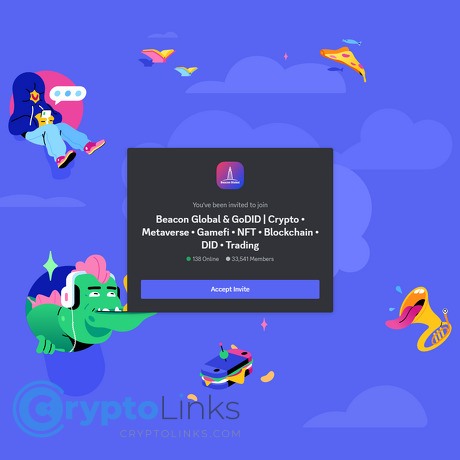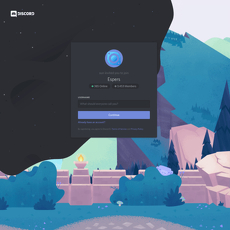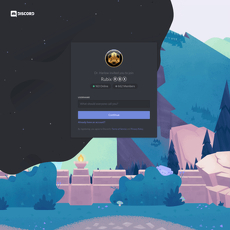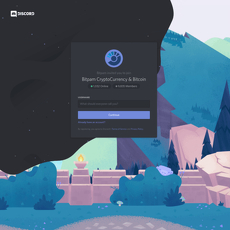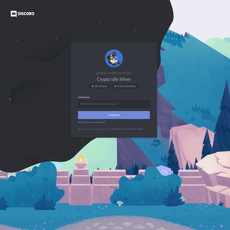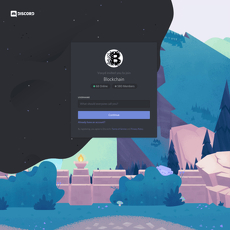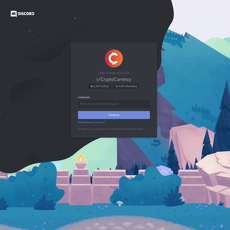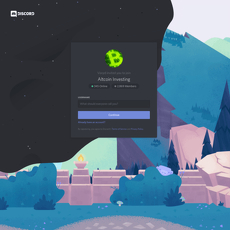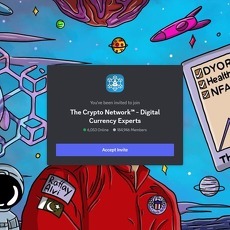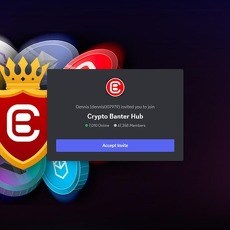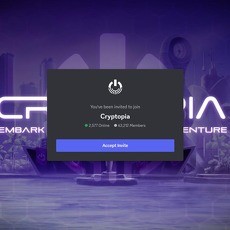Beacon Global & GoDID | Crypto • Metaverse • Gamefi • NFT • Blockchain • DID • Trading Review
Beacon Global & GoDID | Crypto • Metaverse • Gamefi • NFT • Blockchain • DID • Trading
www.linkedin.com
Beacon Global & GoDID Discord Review Guide: Crypto • Metaverse • GameFi • NFT • Blockchain • DID • Trading — Everything You Need To Know + FAQ
Ever joined a “top-tier” crypto Discord, only to get spammed with hype posts, mystery paywalls, and zero real help?
If you’re trying to learn, earn, and actually network without getting buried in noise, you’ll want a straight answer on whether the Beacon Global & GoDID server is worth your attention. You can check it out here: Beacon Global & GoDID Discord invite. I spent time going through what it promises across crypto, metaverse, GameFi, NFTs, DID, and trading—so you don’t waste a week figuring it out.
Why most “all-in-one” crypto servers feel broken
Let’s be real: a lot of big Discords look helpful on the surface, but once you join it’s a churn of noise and upsells. Here’s what usually kills value and attention:
- Endless hype and zero follow-through: “100x gem” screenshots with no context, no invalidation, no risk management.
- Hidden paywalls: Free rooms are dead, “alpha” is locked behind a teaser funnel, and results are never audited.
- Shill storms: Projects pop in for one-time promotions, no due diligence, then disappear. You’re left holding the bag.
- DM scams and impersonators: Fake “support” or airdrop links hit your inbox minutes after joining. Discord’s own Safety hub warns about this—turn off server DMs and assume anything urgent in your inbox is a scam.
- Time sink without signal: Constant pings and channel churn destroy focus. Research from UC Irvine shows frequent interruptions crater productivity and raise stress—your attention is not free currency. (UC Irvine research)
- Safety theater: “No financial advice” disclaimers everywhere, but no real education, no risk frameworks, no warnings on common traps.
On top of that, crypto crime reports continue to flag social engineering—phishing, fake support, and giveaway carts—as a top vector for loss. Chainalysis has highlighted this trend for years. If a server isn’t proactive about link hygiene and mod response, you’re exposed.
Your time is your edge. Protect it like capital.
What I’ll actually do for you here
I’m not here to sell you a dream or dunk on communities. I’m here to help you decide fast if Beacon Global & GoDID belongs in your daily toolkit. I’ll show you how I test a server’s value the same way I’d test a signal service or research shop:
- Map the structure: Channels, roles, and where the real conversations happen.
- Check moderation and safety: Verification, link rules, anti-scam culture, and DM warnings.
- Audit content quality: Are there frameworks, clear trade setups, DID use cases, or just buzzwords?
- Hunt red flags: Pay-to-win funnels, unrealistic returns, whitelist farms, or aggressive giveaways.
- Track outcomes: If there are calls, is there a track record? Are entries, risk, and invalidation posted or conveniently “in hindsight”?
What you’ll walk away with
By the end of this review, you’ll have a plan—not a pile of tabs. Here’s what you’ll get:
- A no-fluff snapshot of what Beacon Global & GoDID actually is and who it seems to serve.
- Safe joining steps so you avoid the classic Discord traps on day one.
- Channel-by-channel expectations across DID, metaverse, GameFi, NFTs, and trading—so you know where to spend time.
- A simple trust checklist for transparency, moderation, and sustainability you can reuse on any server.
- A 7-day mini-plan to test value without burning out: what to read, what to mute, and how to score progress.
If you’re tired of noise and want a practical, step-by-step way to see if Beacon Global & GoDID helps you learn and earn, you’re in the right place.
So what is this server, who’s behind it, and how is it actually organized? Let’s answer that next.
What is Beacon Global & GoDID? The quick snapshot
If you want one hub that talks crypto, metaverse, GameFi, NFTs, blockchain, decentralized identity (DID), and trading in one timeline, this server positions itself as exactly that. It’s pitched as a place to learn, test ideas, and network without the usual noise. Think generalist by design: a cross-chain, cross-topic Discord that tries to connect the dots between identity, on-chain activity, and practical trading.
Join link for quick access, but read the safety notes further below before you click anything.
“Trust isn’t a banner; it’s a breadcrumb trail—clear rules, real names, and receipts.”
Positioning: Crypto, Metaverse, GameFi, NFT, Blockchain, DID, Trading
The scope here is intentionally broad. That’s both the upside and the trap. You get more surface area for discovery—DID use cases today, a new GameFi quest tomorrow, a trading setup on Friday—but you also risk feed overload if the structure isn’t tight.
How I read the intent:
- Crypto and trading: Market updates, chart talk, and risk frameworks for short-term and swing traders.
- NFTs and GameFi: Project discovery, utility checks, and how to avoid “mint first, regret later.”
- Metaverse: Build threads, event/info hubs, and integrations that tie identity to virtual worlds.
- DID (GoDID):Web3 identity as a backbone—verifiable credentials, reputation, and safer access.
In generalist servers, structure decides value. Cognitive load research consistently shows that curated pathways beat raw volume. I look for segmented channels, weekly recaps, and “read-first” pins so you’re not drowning in chatter.
Who’s behind it and how transparent they are
I always check for a visible backbone: who’s steering, and where’s the paper trail?
- Named team vs. anonymous mods: Real names and faces (or at least consistent public pseudonyms) raise accountability.
- Linked assets: Website, X/Twitter, LinkedIn, GitHub (especially important for anything claiming DID tooling).
- Receipts: Past AMAs, published threads, or documented wins/losses. No server gets it right every time, so I prefer teams that show history, not just promises.
- Identity claims: If GoDID is central, I look for references to standards like W3C DIDs, Verifiable Credentials, or Sign-In with Ethereum (EIP‑4361). That’s a signal they speak in specifics, not buzz.
Green flags I like to see:
- A pinned “about” post naming founders/mod leads and linking out to public profiles.
- Clear disclosures on partnerships or affiliations.
- Separate announcement channels where only staff post, with audit trails for edits.
Red flags that make me slow down:
- Everything lives inside Discord, zero external presence.
- Mods asking you to DM for “exclusive alpha.”
- Identity talk with no links to standards, docs, or code.
Server structure and roles
The layout is what makes or breaks a broad-topic server. You should expect a clear “start here” flow and clean sections for learning, signals, and support. Typical structure you’ll likely encounter:
- Orientation: rules, start-here, announcements, role-picker, and a read-first guide.
- Education and research: beginner primers, explainers, DID basics, “how-to” threads for wallets and security.
- Market streams: news-feed, macro-watch, on-chain alerts, and chain-specific updates (e.g., ETH/SOL/BNB).
- Trading corner: setups, risk notes, invalidation chat, and a results/recap log.
- NFT/GameFi tracks: watchlists, due diligence templates, mint calendars, quests/bounties.
- DID lab: identity FAQs, verifiable credential talk, integration notes, and dev updates if GoDID ships tooling.
- Events: AMA calendar, voice rooms, office hours, and recordings.
- Support: help-desk, ticketing, and a scam-report channel.
Roles and bots I look for because they improve signal:
- Interest roles: Trader, Builder, NFT, GameFi, DID—so you can tailor notifications.
- Anti-spam and verification: captcha gate and anti-raid bot before new members see the full server.
- Tools: price alerts, on-chain scanners, reaction-role pickers, and a simple ticketing bot.
Small but powerful markers of quality: pinned weekly recaps, a read-only “alerts” channel, and a living glossary for DID and trading terms. Those save time and reduce noise.
What a safe entry typically looks like:
- Step 1: Hit the rules screen and agree—no DMs for support, no unsolicited promos, scam policy pinned.
- Step 2: Complete a captcha or reaction-verify. If there’s no gate at all, that’s unusual for crypto servers.
- Step 3: Pick interest roles so you only see what you care about.
- Step 4: Skim pinned messages in announcements and “start-here.” Screenshots > slogans.
Quick safety checks I always do before clicking links or signing anything:
- Turn off server DMs: User Settings → Privacy & Safety → disable “Allow DMs from server members.” It blocks the majority of scam approaches.
- Check domains: Only click links from staff-only channels; hover to preview the URL; prefer known domains.
- Never sign blind: If a “mint” or “airdrop” asks for a signature or approval you don’t understand, stop. Read the contract method first.
- Watch for impersonation: Staff won’t DM you first for “support” or “alpha.” If it happens, it’s a fake.
If GoDID tooling is promoted, confirm it against published standards or docs. Real identity projects are proud to show architecture, even at a high level, and often reference W3C DID or VCs. Specifics matter.
All of that is the map. But maps don’t trade for you or teach you much on their own. The real question is simple: when you scroll, do you actually learn something you can use? Let’s test the content next and separate signal from hype—want to see how I pressure-test research, trading calls, DID claims, and project spotlights in under 10 minutes?
Is the content actually useful? My value test
If a crypto Discord can’t save you time, it’s noise. I run a simple filter on Beacon Global & GoDID: does what I read help me act smarter in the next hour, or is it just hype? I use a quick content framework I call the RITE Test — Rationale (why this matters), Invalidation (what would prove it wrong), Transparency (sources, receipts), and Execution (clear next steps).
“Amateurs chase returns. Pros protect risk.” — a rule I keep taped above my screen
Here’s how I score what you’ll typically see inside a crypto–metaverse–GameFi–NFT–DID server like Beacon Global & GoDID, and how to squeeze value without getting pulled into endless scrolling.
Education and research
Education either compounds or it wastes your minutes. I look for content that turns confusion into a checklist you can reuse. The strongest educational threads tend to have:
- Evergreen primers: wallet security, chains/L2s, gas, bridging, tax basics (not advice), and a plain-English glossary. If you can’t onboard a friend with it, it’s fluff.
- Walkthroughs with screenshots: staking, claim flows, signing messages, revoking approvals. Clear steps beat “DYOR” slogans.
- AMAs with timestamps: quick links to the part where tokenomics, runway, or roadmap are addressed, plus a summary for people who can’t attend.
- Actionable frameworks: how to judge a token, game economy, or NFT mint without getting seduced by art or APR.
Here’s a one-pager template I use to judge whether a research post is worth your attention:
- What it is (2 lines, no jargon)
- Who it serves (users, devs, DAOs, gamers)
- Traction (users, revenue, commits, on-chain activity, partners) with links
- Token role (utility, sink, emissions; what creates demand?)
- Concentration (top holders, treasury, unlocks; link to a block explorer)
- Risks & invalidation (what breaks the thesis?)
- Two next steps (watchlist, testnet, call record)
A quick note on learning pace: studies on skill acquisition show that spaced repetition and short, focused sessions beat marathon reads. Aim for 20–30 minute bursts and save the best threads — Discord’s bookmark feature is your friend.
Trading ideas and signals
Signals can be oxygen or poison. The good ones are surgical and testable. Before I act on anything, I look for:
- Clarity: pair, direction, entry zone, stop (hard invalidation), targets, timeframe.
- Reason: the “why” in one sentence (structure break, catalyst, funding flip, on-chain flow).
- Risk: position sizing guidance (e.g., 0.5–1% account risk), not just big targets.
- Receipts: a public, immutable log or monthly scorecard with R-multiples and drawdowns — not cherry-picked wins.
Here’s a sample message format that protects you from FOMO and guesswork:
- Setup: BTC/USDT long
- Entry: 64,200–64,600 (planned scale-in)
- Invalidation: close below 63,700 on 1H
- Targets: 65,500 / 66,800 / 68,200
- Risk: 0.75% account risk, 3R plan, OCO order
- Why: liquidity sweep into 4H demand + positive funding reset; CPI print behind us
And a 30-second pre-trade checklist I recommend using for any Discord call (including here):
- Trend: does the call align with the higher timeframe?
- Invalidation: is the stop where the idea is truly wrong?
- Margin of safety: is the entry chasing or patient?
- Execution: OCO set, alerts on, no manual panic
- Risk: fixed % risk, not fixed size per trade
Why I’m strict: academic work (e.g., Barber & Odean’s research on retail trading behavior) shows overtrading and attention-driven buys hurt outcomes. Track the system, not the excitement. If a server posts results, I want to see losing streaks, not just “10 wins in a row.”
DID focus: What GoDID means in practice
Decentralized Identifiers (DIDs) let you prove things about yourself without handing over your life story. The gold standard is the W3C DID Core spec and the Verifiable Credentials model. What matters to me in a DID-centric community like Beacon Global & GoDID:
- Standards alignment: support for W3C DID methods, credential schemas, and revocation lists.
- Privacy-first claims: zero-knowledge or minimal disclosure proofs for “human” or “member” status without storing PII.
- Real integrations: role-gating on Discord with a verifiable credential, wallet sign-in via EIP-4361, and optional linking to ENS.
- Docs and SDKs: developer guides, repos, example flows, and an issuer/registry you can inspect.
A practical DID flow I like to see demonstrated:
- Mint or register a DID in a supported wallet.
- Request a credential (e.g., “Verified Member” or “Holder of X”) from a listed issuer.
- Prove possession with a privacy-preserving proof to a Discord bot — no leaking sensitive data.
- Auto-assign role and gate channels or events based on that credential.
If the server is serious about DID, you’ll see tutorials, test credentials, and real role-gated perks that don’t ask for personal documents. Identity should be portable, not extractive.
Metaverse, GameFi, and NFT coverage
Hype exploded these categories; the trick is separating community buzz from sustainable economies. I judge coverage by how often they ask hard questions like “Who pays whom, and why will they keep paying?” My go-to filters:
- Players: daily actives, retention, session length (show sources: Dune boards, analytics screenshots).
- Revenue: is money coming from speculation or real sinks (skins, land utility, tournaments)?
- On-chain: holder concentration, marketplace volume, wash-trade flags.
- Economy: emissions vs. sinks, treasury runway, inflation schedule.
- Team: shipped something before? public profiles? consistent updates?
- Tech: chain choice, fees, latency, custody design, upgrade path.
For NFTs, I like to see simple due-diligence posts that include:
- Mint mechanics (supply, allowlist logic, reveal risk)
- Distribution (unique holders %, whale exposure)
- Utility (access, IP rights, staking risks, token tie-ins)
- Security (official links, contract audits, revocation guidance)
Industry analyses (e.g., Chainalysis reports) have shown persistent NFT wash trading and scam patterns. So if a spotlight channel exists, I’m looking for evidence-backed highlights, not recycled Twitter threads. A single chart that explains user retention beats ten “to the moon” memes.
For beginners vs. advanced users
Not every channel helps everyone. Here’s how I would route people inside a broad server like Beacon Global & GoDID:
- Beginners:
- Start with security and wallet threads, then “how to read a token page” posts.
- Join one AMA this week; ask one question; read the summary afterward.
- Skip signals for 7 days. Build a watchlist and practice with alerts only.
- Intermediate:
- Use research checklists. Attempt one structured trade per week with fixed risk.
- Test a DID credential flow; connect it to a role-gated channel or perk.
- Contribute: post a mini-due-diligence on one project using the one-pager template.
- Advanced:
- Look for raw feeds: orderflow snapshots, funding/oi dashboards, governance calendars.
- Ask for receipts: month-end PnL with R-multiples, not just win rates.
- Kick the tires on SDKs/APIs if DID tooling is a focus; review repos and issue trackers.
One more reminder on pacing: short, consistent reps beat binge research. As James Clear puts it,
“You do not rise to the level of your goals. You fall to the level of your systems.”
Choose your three highest-signal channels, mute the rest, and build a system that fits your day — not the other way around.
All of this only matters if you can learn and participate safely. Are the links clean, are DMs locked down, and do mods kill scams before they spread? That’s exactly what I stress test next — want to see what I check first and the fastest way to avoid getting burned?
Safety, trust, and moderation: what I check before recommending
Good information is useless if the environment is unsafe. Before I spend time in any crypto Discord (including Beacon Global & GoDID), I pressure-test security, moderation, and transparency. If a server can’t protect you from wallet-drainers, impersonators, or time-taxing spam, it doesn’t matter how shiny the crypto, metaverse, GameFi, NFT, DID, or trading talk is.
“Trust is a feature, not a vibe. If it isn’t visible, it isn’t there.”
Security practices
Here’s the baseline I expect to see the moment I join. If I don’t, I act like every link is radioactive.
- Onboarding gate: A clear verification flow (Captcha, membership screening, basic rules). This keeps throwaway scam accounts from flooding DMs.
- DM safety warnings: Pinned message that says “No admin will DM you first.” If this sentence is missing, that’s a hole big enough for airdrop phishers to drive a truck through.
- Link hygiene: Only official domains allowed, no shortened links, and auto-deletion of suspicious URLs. A separate “official-links” channel that’s locked to staff is a strong signal.
- Anti-scam filters: Discord AutoMod or a bot configured to nuke common phishing patterns (fake airdrops, Unicode lookalikes, .zip/.scr attachments). Ask yourself: do spam links survive for minutes or hours?
- Wallet safety culture: Regular reminders to use a burner wallet for mints and unknown contracts, plus resources to revoke approvals and install protections like Wallet Guard.
60-second safety check you can do today:
- Disable “Allow direct messages from server members” for the server.
- Open the rules and pinned messages in the main channels. Look for explicit DM and link policies.
- Scan for an “official-links” channel and compare those domains to posts in public chat. Inconsistencies = red flag.
Reality check: Social engineering is still the top attack vector in crypto communities. The FTC reported over $1B in consumer losses tied to crypto scams since 2021, much of it starting on social platforms. The pattern is always the same: urgent DM, fake support, or “exclusive” mint. If the server builds strong DM and link hygiene, your risk drops fast.
Scenario you should be ready for: A “collab manager” DMs you an .exe or .zip claiming it’s an NFT partnership. The right move: report to mods, block, and never run files from Discord. If you connected a wallet anywhere suspicious, revoke approvals at revoke.cash immediately.
Moderation quality
Strong communities don’t tolerate chaos. I test three things right away:
- Response time: When spam appears, is it gone within a minute? If it lingers, assume scammers can, too.
- Consistency: Are rules enforced evenly for everyone, or do insiders get a pass? Double standards invite shills.
- Tone: Do mods answer newbie questions respectfully? If beginners get roasted, real builders won’t stick around.
15-minute field test:
- Report a clear spam link via the server’s report tool or mod ping. Time the cleanup.
- Ask a basic question in the appropriate help channel. Note how long it takes to get a useful reply.
- Check how they handle off-topic self-promo. One strike policy and channel locks = good discipline.
In crypto, “fast” moderation is a security feature. The longer a malicious link stays live, the more wallets get drained. I want to see proactive bans, not reactive apologies.
Transparency and sustainability
Crypto Discords often hide the business model. I look for daylight:
- Clear web presence: Website/docs that match the Discord branding and list team roles, partner links, and official socials. If Beacon Global & GoDID mentions a DID angle, I expect a high-level explainer and a link to docs.
- Revenue model: Is it free? Are there paid tiers? Are affiliate links disclosed? If trading or NFT calls are monetized, how are results tracked and disclosed?
- Disclaimers: “Not financial advice,” risk notes, and clear boundaries on what staff will or won’t do (no DMs, no wallet connections, no screen-sharing for “support”).
- Audit and partner statements: For DID or tooling claims, look for technical write-ups, audits, or at least a roadmap that explains how user data and keys are handled. DID should mean user control, not a shadow KYC.
Quick DID-specific check: If they promote decentralized identity, ask:
- Which DID method is used (e.g., did:ion, did:key, did:ethr)?
- Where are keys stored and rotated?
- Does any partner require full KYC? If yes, why, and how is it secured?
If those answers aren’t public or consistent, treat identity claims as marketing until proven.
Red flags to watch
- Pay-to-win pressure: “Unlock 90% win-rate signals” or time-limited upsells that prey on FOMO.
- Guaranteed returns: Any promise of profits in trading, GameFi yields, or NFT flips is an instant no.
- Whitelist farming: Aggressive quests that ask for mass tagging, spamming, or installing unknown apps.
- Impersonators: Accounts with near-identical names to staff offering “priority verification.” Real staff won’t DM you first.
- Off-platform payments: Requests to pay in crypto via DM for “premium” channels. If paid tiers exist, they should use transparent, official checkout only.
- Unknown domains: Any request to connect a wallet on a new domain that’s not in the locked official-links channel.
My safety mini-checklist (save this):
- Disable server DMs, verify once, and never screen-share wallet or seed phrases.
- Use a burner wallet for mints/GameFi tests; keep your main wallet offline.
- Only click links from the locked official-links channel; double-check misspellings.
- Install browser and wallet protections (Wallet Guard, revoke.cash).
- Report anything weird. Good mods will thank you; bad ones will ignore you.
If Beacon Global & GoDID keeps scams out, responds fast, and stays honest about how it makes money, you can actually relax and learn. If not, you’ll spend your time dodging landmines instead of leveling up.
So what does a normal day in the server feel like when the guardrails are in place—are the chats active, are the AMAs worthwhile, and where do the best conversations actually happen without turning your notifications into chaos? Let’s find out next.
The community experience: activity, events, and tools
“Signal beats noise. Curate or be crushed.”
If you’ve ever joined a “mega” crypto Discord and felt your brain melt from pings and price spam, you know the real test isn’t features—it’s daily flow. Here’s what life actually feels like inside the Beacon Global & GoDID Discord and how to get the most out of it across crypto, metaverse, GameFi, NFTs, DID, and trading—without getting swallowed by the feed.
Activity and engagement
Large crypto servers often look huge but “talk” tiny. That’s normal. Online communities follow the 90–9–1 rule: ~1% create, 9% contribute, 90% mostly lurk (source: Nielsen Norman Group). What matters is whether the 10% are sharing useful ideas you can act on.
Here’s how I gauge real activity vs. vanity numbers and what to check the moment you join:
- Look for threaded conversations in research, market-chat, DID/identity, and builder channels. Threads signal actual collaboration (not just emojis and “gm”).
- Scan the last 48 hours: Are members posting links to on-chain data, docs, or dashboards—or just screenshots and price hops?
- Use Discord search for terms like “risk,” “invalidation,” “contract,” “docs,” “DID method,” “revocation,” “tokenomics” to find signal-heavy pockets fast.
- Test responsiveness: Ask a concrete question (e.g., “Where do I find the DID schema for X?” or “Any invalidation level on that BTC short?”). Time how long helpful replies take.
- Check timezone rhythm: Most crypto chats hum in three waves—Asia AM, EU afternoon, US evening. Expect the strongest cross-talk during EU–US overlap.
A healthy daily loop in Beacon Global & GoDID looks like this: a member shares a new GameFi token with an Etherscan link, someone else drops a Dune query or Dexscreener chart, a mod asks for risk/invalidation, and a DID-focused member adds a note about the team’s identity or verifiable credentials. When I see that pattern, I stick around.
One more reason to filter early: research shows that every interruption can cost real focus time, not seconds. Studies from UCI found it takes around 23 minutes on average to recover after a disruption (Mark et al., UCI). If you’re allergic to ping-floods, curating your view isn’t optional—it’s survival.
Events and opportunities
You’ll usually see a mix of AMAs, workshops, office hours, and occasional airdrops/giveaways. The goal isn’t to attend everything—it’s to pick the one or two that match your edge.
How I separate real value from hype:
- AMA quality tells you everything: Are questions pre-screened softball promos, or do hosts press on roadmap risks, DID verification, data custody, and token unlocks?
- Workshops should end with a result: e.g., “Set up a DID wallet and issue a verifiable credential” or “Build a TradingView alert + risk framework.” If it’s all buzzwords, pass.
- Airdrops/giveaways sanity check: No wallet connects during live calls. No “send 0.1 ETH to get 1 ETH back.” Use a burner wallet if you must test anything. Keep DMs off.
- Office hours vs. pitch hours: Real office hours are for open Q&A with mods or analysts. If it feels like one long shill, you already have your answer.
Smart participation playbook:
- Bookmark the events channel and set a custom notification only for “AMA” or “Workshop” in the title.
- Before an AMA, skim the project’s docs and ask one question that tests execution (e.g., “How do you handle DID revocation lists at scale?”).
- After any call, check if the promised resources are posted: slides, code, links, or a recap. No recap, low effort—move on.
- For giveaways, treat everything as guilty until proven safe. Chainalysis reports show scams remain a top on-chain threat (Chainalysis Crypto Crime Report).
Built-in tools and bots
The best servers help you filter. Beacon Global & GoDID typically features a core stack of alert channels and bots you can tune to your goals:
- Price and market bots: Quick lookups for BTC/ETH/alt pairs, gas, and dominance. Use slash commands if available (e.g., /price BTC, /gas), then set your watchlist.
- On-chain activity alerts: Whale transfers, new token listings on DEXs, or unusual volume. Don’t chase—add to a watchlist and validate with contract age, holders, and liquidity locks.
- News aggregators: A curated feed beats 10 open tabs. Skim headlines, click only if it impacts your thesis (DID standards, Layer2 launches, marketplace policies).
- Identity/DID tools: Links to DID methods, verifiable credential demos, or proofs. Use these to test real workflows instead of just reading about them.
Pro setup tips:
- Create a “Followed” feed: many announcement channels let you Follow posts into your own private server to reduce noise.
- Set Notification Overrides per channel: “Only @mentions” for news, “All messages” for your main research thread, mute the rest.
- Spot-check bot authenticity: look for the Verified Bot badge, minimal permissions, and a known developer page. If a bot asks for unnecessary permissions, skip.
- Build a quick checklist: contract link → age → holders → liquidity → team socials → DID or credential claims → roadmaps. Turn it into a saved note so you never rush.
Mobile vs. desktop tips
Crypto never sleeps, but you should. Here’s how to keep Beacon Global & GoDID useful on both phone and desktop.
On mobile (iOS/Android):
- Long-press a channel → Mute 8 hours/24 hours/Until you turn it back on. Use “Only @mentions” as your default.
- Open Server Settings → Notification Settings → toggle Suppress @everyone and @here.
- Turn off Allow DMs from server members for extra safety (Server → Privacy Settings).
- Create a folder called “Alpha” and drop only your top 3–5 channels there. Everything else lives muted.
On desktop:
- Right-click the server → Notification Settings → “Only @mentions,” then add Notification Overrides for 2–3 key channels.
- Enable Hide Muted Channels for a clean sidebar. Your brain will thank you.
- Use Ctrl/Cmd + K to Quick Switch to threads you follow. Star or pin must-reads.
- Open Threads → set “Auto-follow” to Off. Manually follow only the ones that match your thesis.
If you’re serious about DID or trading, set a 15-minute daily routine: scan the announcements channel, run your saved bot commands, check one research thread, and leave. Protect your attention like it’s capital—because it is.
Want a fast setup that locks this in without the noise? In the next section, I’ll show the exact 10-minute join flow and a 7-day mini-plan that tells you—objectively—if Beacon Global & GoDID deserves a spot in your day. How much time are you willing to invest to find out?
Getting started, alternatives, and helpful links
Step-by-step: join and set up in 10 minutes
I don’t want you stuck in setup purgatory. Here’s the fastest way to join Beacon Global & GoDID and make it work for you right away.
- 1) Join + verify: Use the invite, complete any captcha/Reaction-role verification, and wait for channels to unlock. If verification looks sketchy (weird external sites), stop and ask a mod in the public help channel first.
- 2) Lock down DMs: Click the server name → Privacy Settings → toggle OFF “Allow direct messages from server members.” This kills 90% of scam DMs before they start.
- 3) Read rules once, avoid pain later: Skim #rules and #start-here. Look for how they handle shilling, self-promo, and posting links. Consistent rules usually mean less noise.
- 4) Pick roles to tailor your feed: Grab roles that match what you want: Trading, NFT, Metaverse, GameFi, DID. Avoid “select all” or you’ll drown in pings.
- 5) Mute 80% of channels: Right-click channels you don’t need → Mute → “Until I turn it back on.” Keep notification settings to “Only @mentions.” Your focus is your edge.
- 6) Bookmark your power trio: Pin the 3 channels that match your current goal. For example:
- Trading goal: #announcements, #research-hub, #signal-feed
- Builder/DID goal: #announcements, #did-tools, #dev-resources
- NFT/Metaverse goal: #announcements, #project-spotlight, #events
Tip: Use “Pins” in each channel to find the best posts fast.
- 7) Set smart alerts: If the server uses price or news bots, create two alerts (e.g., BTC/ETH levels + one GameFi token you care about). Start small to reduce signal fatigue.
- 8) Prep a burner wallet: For airdrops, mints, or DID experiments, use a fresh wallet with limited funds. Never connect your main wallet to anything you haven’t vetted.
- 9) Introduce yourself with intent: Post a one-liner in #introductions: who you are, what you want, and one thing you can offer. Clear intent attracts the right people.
- 10) Set a daily cap: 20–30 minutes max. Overconsumption kills outcomes. Quality > quantity.
7-day mini-plan to test value
I built this so you can judge the server on real progress, not vibes. It uses basic behavioral science: time-boxing boosts follow-through, and spaced learning beats binge-reading.
- Day 1 — Map the value
- Read pinned posts in your 3 key channels.
- Find the event calendar and the help channel.
- Ask one specific question tied to your goal (e.g., “Any recent DID case studies beyond domain handles?”).
- Day 2 — Education first
- Read 2 beginner-to-intermediate guides in #education or #research-hub.
- Write a 5-sentence summary for yourself. Spaced recall beats passive reading.
- Day 3 — Set up tools
- Create two bot alerts (one price, one on-chain/news if available).
- Build a mini watchlist: 3 tokens or projects max (e.g., 1 Trading, 1 NFT/Metaverse, 1 DID).
- Day 4 — Join one event
- Attend an AMA/workshop or watch a recording.
- Post one takeaway in the thread. People who share get noticed by serious members.
- Day 5 — Paper trade one idea
- Pick a trade idea posted with clear entry, invalidation, and risk.
- Paper trade it with strict rules: risk 0.5–1% per idea, pre-set stop, no revenge trades. Track the result.
- Day 6 — Try one DID action
- Use a burner wallet to test a DID tool (e.g., linking a handle, checking verifiable credentials).
- Document what worked, what felt clunky, and any security concerns.
- Day 7 — Decide with a scorecard
- Rate 1–5:
- Signal quality (useful posts vs. hype)
- Safety (clear rules, scam prevention, no shady links)
- Time ROI (did 20–30 min/day move you forward?)
- Goal fit (trading, DID, GameFi, NFT, Metaverse)
- If it’s 15+ total, keep going. If not, prune channels or move on.
- If there’s a paid tier, don’t upgrade unless you see transparent tracking, audited results, and risk-first education—not just screenshots.
- Rate 1–5:
Who should join (and who shouldn’t)
Not every server should be “for everyone.” Here’s the honest filter.
- Join if you’re:
- A curious learner who wants a broad crypto hub spanning Trading, NFTs, Metaverse, GameFi, Blockchain, and DID.
- A builder or researcher who values mixed content (tools, case studies, AMAs) over pure hype.
- A part-time trader who wants structured feeds, risk-labeled calls, and a place to sanity-check ideas.
- Someone who enjoys experimenting with DID and identity in Web3, safely.
- Skip if you’re:
- Only after high-frequency signals and rapid-fire scalps 24/7.
- Expecting guaranteed returns or quick riches (that mindset gets punished, fast).
- Looking for ultra-deep alpha in one niche only (e.g., just Solana NFTs, just options flow).
- Allergic to notifications and not willing to mute aggressively.
60-second self-check (yes/no):
- I can focus on 1–2 goals for 30 minutes a day.
- I’m okay testing tools with a burner wallet.
- I’ll log trades and ideas before I click anything.
- I prefer practical guides over constant memes.
- I’m comfortable asking questions and giving short feedback.
Four “yes” answers? You’ll probably get value here.
Helpful resources and similar picks
If you want a backup plan or a comparison set, here’s how I frame it:
- Pure trading communities: Look for transparent PnL tracking, archived calls with timestamps, and a public risk framework. If entries/invalidation aren’t posted up front, pass.
- NFT/Metaverse hubs: Favor servers that post due-diligence templates, not just “WL soon” spam. Bonus points for on-chain dashboards and social sentiment summaries.
- GameFi groups: Pick ones that track token emissions, player retention, and treasury runway. “Daily rewards” without tokenomics context is noise.
- DID/Identity circles: Prioritize communities that show real use cases—sign-in demos, verifiable credentials, and interoperability talk—over buzzwords.
Use this fast evaluation checklist for any alternative:
- Safety: DM rules, link filters, scam warnings in place?
- Proof: Pinned wins and losses, not just screenshots?
- Structure: Clear channels, pinned guides, event calendar?
- Fit: At least 70% of posts align with your current goal?
- Time: Can you configure it to no pings except your 3 core channels?
“The goal isn’t to find the loudest server—it’s to create a quiet system that produces consistent wins for you.”
Want to know if Beacon Global & GoDID actually clears my bar across transparency, content quality, and moderation—and see quick answers to what everyone asks before joining? That’s exactly what I tackle next.
FAQ and final verdict
Quick answers to what people ask
Is the Beacon Global & GoDID Discord free?
Yes, you can join via the public invite. If you ever see paid tiers, treat them as optional extras and always ask for a public track record, refund policy, and what’s actually gated.
Is it safe to connect my wallet or claim “airdrops” shared in chat?
Default to no. Keep DMs closed, never sign blind signatures, and use a burner wallet for anything experimental. 74% of breaches involve the human element according to Verizon’s DBIR. Scam links commonly spread on Discord, so treat every link like it could be hostile. If the server has a “trusted links” list, stick to it.
Are the trading calls any good?
Some are structured; some are chatty. What I look for: clear entries, invalidation, risk per trade, time horizon, and a scoreboard that includes losers. A solid call looks like: “BTC long plan: 58,400 / 58,000 DCA, SL 57,200, targets 59,600 / 60,800, 0.5% risk per leg, thesis: sweep + reclaim, chart link.” If the record isn’t tracked publicly and losers aren’t posted, treat it as entertainment, not strategy.
What is GoDID and why should I care?
DID stands for Decentralized Identifier. It’s a way to prove identity or reputation across apps without handing your data to a middleman. Practical uses: signing into apps, proving ownership of assets, or moving your reputation from one platform to another. If the server offers hands-on guides, try them with a burner identity first. For background, see W3C’s DID Core spec.
Can beginners keep up?
Yes, if you mute aggressively and follow a short list of channels. Start with education and read-only news. Skip advanced alpha until you understand risk and how to size positions.
How do they handle scams and DMs?
Look for pin posts reminding you to disable DMs, bot filters for fresh accounts, link warnings, and mod responses within minutes when spam hits. Chainalysis notes social-engineering scams continue to be a major problem in crypto, so the only safe approach is layered defense and healthy skepticism.
Is there real value beyond hype?
Yes if you stick to structured areas: curated research threads, recorded AMAs, and channels that require sources. Avoid the FOMO pits and stick to content that explains the “why,” not just “buy.”
Do I need to be active daily?
No. Set alerts for a few channels that match your goals and batch your catch-up. You’ll get 80% of the value with 20% of the time if you avoid real-time chatter.
Is Beacon Global & GoDID legit and worth your time?
I judge any crypto server on five things: transparency, content quality, safety, moderation, and fit for your goals.
- Where it shines: broad coverage across crypto, NFTs, GameFi, metaverse, and DID; regular learning opportunities; a mix of tools and market talk that keeps you current. Good for people who like a single hub and want to explore identity and trading without joining five different places.
- Where it can fall short: breadth can mean noise. Signals and alpha vary in depth. I’d like to see more rigorous post-trade reviews and a public archive of wins and losses. If there are any paid relationships or affiliates, a transparent disclosure page makes everyone’s life easier.
- Who benefits most: curious learners, early builders, and part-time traders who value community and discovery. If you’re a pure scalper or you only care about one niche (like NFTs only), you may prefer a specialized, smaller server.
My take: it’s a legit, active hub if you approach it with a filter. Mute the noise, follow the channels that match your goals, and hold any alpha to the same standards you’d expect from yourself—clear setups, clear risk, and receipts.
If not this, then what?
Pick alternatives by niche and apply a quick checklist before committing time.
Pure trading (education-first): Look for communities that share frameworks, not just calls. A public playbook, weekly post-mortems, and a shared glossary beat “green candle = buy.” Consider supplementing Discord with TradingView ideas and well-documented educators.
NFT/GameFi alpha: Favor servers that cite on-chain data and user metrics over influencer hype. Pair any server with analytics communities like Dune and DeFiLlama to validate claims.
DID/Web3 identity builders: Join protocol communities where specs and code live, such as ENS, W3C DID Core (read the spec), and identity-focused projects like SpruceID. You’ll get closer to the tech and standards that matter.
Developers and builders: If your focus is shipping, jump into the chain-specific hubs like Ethereum or Solana and stick to dev channels.
Fast Discord checklist (use this anywhere):
- Is there a rules channel and a clear “no DMs” warning?
- Do calls include entry, invalidation, risk sizing, and follow-ups?
- Are losers tracked publicly, not silently deleted?
- Are links curated and pinned? Any phishing warnings?
- Is there a revenue model disclosure (free, paid, affiliate)?
- Is the chat signal-to-noise ratio acceptable after muting 80% of channels?
- Can you learn something useful in 20 minutes a day?
Final word
Your time is your edge. Use it where the signals are clear and the receipts are public.
If this server matches your goals and passes your 7-day test, keep it in your stack. If it feels loud, salesy, or thin on evidence, move on without guilt. There’s always another community, but there’s only one you.
CryptoLinks.com does not endorse, promote, or associate with Discord servers that offer or imply unrealistic returns through potentially unethical practices. Our mission remains to guide the community toward safe, informed, and ethical participation in the cryptocurrency space. We urge our readers and the wider crypto community to remain vigilant, to conduct thorough research, and to always consider the broader implications of their investment choices.

